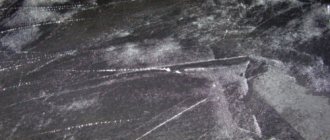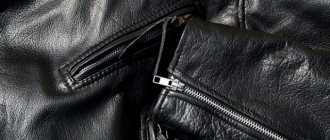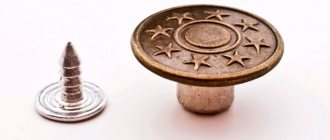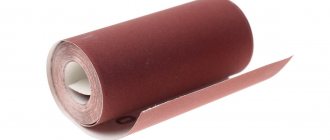What is this text about? In this text we will answer the following questions: how to repair a hole on a Bologna jacket video how to put a patch on a Bologna jacket how to repair a cut on a leather jacket How to repair a hole on a down jacket at home
If outerwear is worn out and has lost its former appearance, you can purchase a new item or repair the old one. There are several ways to repair a hole in a down jacket to return the garment to its original appearance.
If your jacket is torn, what should you do: first, inspect the product. It may be irrational to spend money on repairing it. However, you can sew up a hole along the seam yourself, and decorate the hole in a visible place.
Patches and accessories for decorating defects
If the down jacket is torn in a visible place and you need to hide the flaw, a patch will help. You can buy it in a specialized store with sewing accessories.
Decorative patches come in various shapes and colors. From a wide range, you need to choose the option that will look appropriate on a down jacket and is combined with the material of the product and the style of clothing.
Stores sell bright patches with company logos, cartoon characters, animals, flowers and other images. Some elements have an adhesive backing, others do not.
To hide a defect on a product, you can purchase metal or plastic accessories: buttons, zippers, snaps. The decor is attached to the surface of the fabric with your own hands. In difficult cases, the task can be entrusted to specialists.
For long and narrow cuts, you will need decorative tape, which is cut to length according to the size of the hole and carefully glued.
Combating defects in bolognese products
Many consumers probably remember the time when bologna jackets were at the height of popularity. For their manufacture, a special nylon fabric is used, which includes a unique waterproof coating. But even in the modern world, such products are very popular, because they are affordable for every category of consumer, and also protect well from piercing wind and rain in bad weather.
Despite significant advantages, such jackets have a main drawback - the relatively low strength of the material. One wrong move, and the jacket can easily be damaged due to mechanical or chemical effects. As practice shows, it is precisely such holes that are much more difficult to repair accurately. Before sewing up a Bolognese jacket, you need to assess the nature of the damage and the quality of the product itself.
Experts say that to eliminate a burn, rupture or cut, you must adhere to several rules:
- At the first stage, you need to choose the right adhesive composition for repairing outerwear. To do this, you should carefully study the label located on the inner lining of the jacket. It is best if the selected glue is tested on a small area of clothing that is invisible to prying eyes. Experts say that glue that contains a special ester of acetic acid and rubber has good properties. If such an option is simply not at hand, then you can give your preference to “Moment” glue.
- Now it's time to carefully cut the patch to fit the cut. A small piece of fabric made of rubberized material or bologna will look most organic and attractive. It is worth noting that the color of the patch and the jacket itself must match.
- The inside of the product must be thoroughly wiped with a cotton pad, which must be pre-moistened in acetone. After these manipulations, the jacket should lie for several minutes.
- At this stage, you need to apply glue to the patch (all manipulations must comply with the instructions). Be sure to wait a few minutes.
- Gradually glue a piece of fabric on the wrong side. To record the result, you need to place a small press on the treated area, the weight of which should be at least 2 kg. Wait 3 hours.
- There are situations when from the front side the gap looks very sloppy, then this place can be decorated with an appliqué of a suitable size and color.
It is also worth considering that some experts prefer to use a shorter and more reliable method of dealing with holes in jackets. The process itself consists of three mandatory steps:
- You can quickly and efficiently repair a torn item using two patches. First of all, you need to trim the edges of the hole with ordinary sharp scissors.
- Preparing bologna patches. It is worth noting that the piece of material that will be attached to the inside must be larger in diameter than the hole itself. But the front patch must exactly match in diameter.
- All that remains is to tape the damaged areas on the jacket to hide the damaged areas. After the manipulations have been performed, it is imperative to evaluate the result of the work done. If you are satisfied with it, then you need to cover the jacket with a fabric made of natural material (cotton, linen) and carefully iron it.
If it is not possible to hide defects with improvised means, then it is best to contact a specialized studio.
Sewing a jacket at the seam
It is quite easy to work with a hole that runs along the seam of the product. For repairs you will need a thread to match the color of the existing seam and a needle.
First, the item is turned inside out. If there is a lining, it must be ripped open at the tear site. After this, you can proceed directly to the process of correcting the problem.
You can sew up a hole in the jacket by hand or with a sewing machine. If the flaw is small, a thread and a needle is enough. For a strong seam, it is recommended to use two layers of thread. There is no need to tighten too much to prevent wrinkles from forming. The outer surface of the canvas should remain flat.
After completion of the work, other closely spaced seams are also inspected for holes. If the threads are separated, the stitching is strengthened. The final stage is sewing up the lining.
Preparing to seal the hole
How to seal a bolognese jacket? If holes have formed in a pocket, sleeve or along a seam and now the hole significantly spoils the appearance of the outerwear, it needs to be repaired urgently. A patch that will repair cuts, pockets, sleeves and seams is perfect for this. But, unfortunately, at present, at home, a person can only tape his jacket so that the hole is completely masked. How to fix a hole in a jacket with glue? This will be done with a special glue that allows you to close the base of cuts or burns in jackets.
How to disguise a cut or holes on outerwear if it is made of leather?
We suggest you familiarize yourself with Thinsulate on how to wash a jacket in a washing machine
To seal the hole you will need:
- glue;
- acetone;
- cotton wool;
- iron;
- press;
- scraps to make a patch;
- scissors;
- canvas, which must be dry;
- blade.
To sew your jacket, it is important to follow some tips. First, you need to carefully inspect the burned or cut bologna for damage. After this, the holes and seams of the product are assessed (you also need to pay attention to the lining). If the damage is minor, you can start creating a patch.
Sewing a hole with a blind stitch
The hidden stitch should run from the inside of the product, remaining invisible from the outside. To disguise the tear, select a thread and a thin needle that matches the color of the outer material of the jacket. There are a large number of hidden seams; you need to choose any of them and seal the hole.
If it is possible to sew up the defect only from the front side, both parts of the incision are fastened and stitched with a needle alternately. The resulting seam tightens and makes the fabric on top visually solid.
Decorative elements
Of course, sewing up a hole in a jacket is quite simple, but you can give your preference to a simpler option - masking the damaged area with original embroidery, sticker or even appliqué. But this method has one drawback - colorful patterns, chevrons and monograms do not look appropriate in all places.
You can give your preference to traditional embroidery, which is first applied to a separate piece of fabric, leaving an allowance of 0.7 cm on each edge. After carefully ironing the workpiece, it can be safely sewn to a jacket or coat.
Burnt hole on things
If a person accidentally burns a down jacket, it is necessary to correct and eliminate the flaw so that the small hole does not increase in size over time. You can do this in the following ways:
- Using additional accessories. The method is suitable in cases where the product already has spikes, buttons and other decorative elements. At the burn site, you need to secure a similar part using glue.
- If the hole is large, it is most effective to cover it with prepared patches on both sides - both the back and the front. To make the repair area invisible, it is recommended to decorate the patches with embroidery or an appropriate design on top.
- To eliminate the hole on the front lower part of the trigger, you can sew an additional pocket. The detail may be the same color as the product or may differ from the main palette. The main thing is that the pocket looks harmonious and does not catch the eye. You can choose a sewn-on element at a hardware and sewing supplies store.
- Using iron-on adhesive or patches is an excellent and inexpensive solution. For an adult wardrobe, it is recommended to choose discreet elements, for a child’s wardrobe - bright and colorful.
How to install the patch
First, sew up the torn pocket, sleeve or other part of the jacket (lining) so that it cannot ruin the process of gluing the patch. How to sew a pocket? Usually it is sewn up with white threads from the inside, without making strong stitches.
After this you can start gluing the patch:
- To begin with, we choose the right adhesive base, which should properly glue the bologna. In this case, the selected glue, which should close the hole on the base of the jackets, must be rubber (for example, Moment).
- Now, to sew up the jacket with your own hands, you need to make a couple of patches (each is done using bologna fabric or rubber of the same color). In this case, each patch (the second one is made as a reserve) must be the same size as the burnt or cut hole. They are made using a cloth and scissors.
- When several patches have been made, on jackets with a hole we wipe the damaged area with acetone - this is usually done with a cotton swab. It is necessary to wipe any surface: the base of the seam, between the sleeves or the sleeve itself, between the seam, in pockets, and so on. After that, wait a few minutes (thick Bolognese products will take a little longer).
- How to seal a hole? We apply glue to the previously made patch (how to do this correctly is written on the packaging), and then see that its entire base has been covered with the adhesive mass.
- Carefully and carefully carry out the homemade sealing, since bologna is too “fragile” material - make sure that the patch covers the entire hole in the material. After this, to prevent the fabric from tearing, we apply a bag to the patch, and then press it with a press, the weight of which should be at least a kilogram. All linings of the product must be hidden, and then also pressed with a press.
We suggest you familiarize yourself with Flushing the engine when changing the oil: is it necessary to flush the engine when changing the oil, flushing oil for the engine
If the work was done unsatisfactorily and the patch turned out to have a large seam, you can glue it to the inside of the jacket (however, in this case the lining often gets in the way, which means it will need to be carefully removed). After installing the patches, sew up the lining, and if the cut area still looks unsatisfactory, try decorating it.
If the jacket's warping has a slight cut, make a patch as described above, and then iron it through the fabric.
Cigarettes, small household waste and other items can easily ruin the appearance of bologna jackets.
Therefore, if their integrity is violated, we seal the resulting holes with a patch - this will be much easier than sewing up the holes.
Even an inexperienced person can start gluing the bologna, since there is nothing complicated in this process.
How to seal a hole correctly
Textile patches are not only sewn on, but also glued. In order to properly seal the down jacket, you first need to degrease the defect area. Acetone or another solvent will help with this. The liquid is applied to clothing using a cotton pad.
Select an adhesive composition suitable for the fabric. It can be rubber or caoutchouc glue, “Moment”.
For a good result, it is recommended to test the product on an inconspicuous part of the down jacket fabric. When applying it, you must strictly follow the instructions.
To apply the glue in an even layer, use a brush or cotton swab. The cut fabric is placed on glue and pressed. It is recommended to leave the item under pressure for a while.
How to remove stains from a blazer
- Remove fresh grease stains with laundry soap. Lather the stain and leave it overnight, then wash as usual;
- Sprinkle greasy marks with salt and leave for a few minutes. Rub the material with salt until the grease and stains completely disappear;
- Grease stains from light-colored material are removed using ammonia. Wipe the contaminated areas with a clean cloth. Treat only the necessary areas, otherwise the fabric will become discolored in other places!;
- Dilute dry mustard powder in a volume of two tablespoons with water until you obtain a mushy mixture. Apply the composition to the problem area and leave for an hour, then wash the clothes in a soapy solution;
- Take table vinegar and soak a cotton pad, then treat the affected areas and wash the jacket as usual;
- Heated potato starch will remove old stains. Wet the dirty areas with the product and leave for a few minutes. Then wipe the treated areas with a dry cloth;
- Bread crumb effectively removes all types of stains. Apply a piece of bread to the contaminated areas and leave for two to three hours. After this, wash the product by hand with powder or other suitable detergent;
- Stubborn old stains can be removed with dishwashing detergent. In this case, drop a little mixture onto the dirt and rub the solution until foam forms. Leave for two to three hours and then rinse under running water;
- An effective method is to use tooth powder. Sprinkle the product onto the dirty areas and wipe with a soft brush. Finally, wash and dry the jacket;
- The greasy shine that often appears on collars, cuffs and pockets can be removed with vinegar or baking soda. Place or pour a small amount of product onto a cotton pad and wipe the desired areas.











